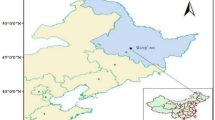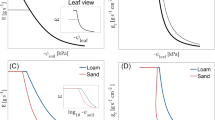Abstract
An attempt has been made to study the effect of elevated temperature on soil hydrothermal regimes and winter wheat growth under simulated warming in temperature gradient tunnel (TGT). Results showed that bulk density (BDs) of 0, 0.9, and 2.5 °C were significantly different whereas BDs of 2.8 and 3.5 °C were not significantly different. Water filled pore space (WFPS) was maximum at 3.5 °C temperature rise and varied between 43.80 and 98.55%. Soil surface temperature (ST) at different dates of sowing increased with rise in sensor temperature and highest ST was observed at S5 sensors (3.5 °C temperature rise). Temperature and its difference were high for the top soil, and were stable for the deep soil. Photosynthesis rate (μmol CO2 m−2 s−1) of wheat was lower at higher temperature in different growth stages of wheat. In wheat, stomatal conductance declined from 0.67 to 0.44 mol m−2 s−1 with temperature rise. Stomatal conductance decreased with increase in soil temperature and gravimetric soil moisture content (SWC). In TGT, 0 °C temperature rise showed highest root weight density (RWD) (5.95 mg cm−3); whereas, 2.8 and 3.5 °C showed lowest RWD (4.90 mg cm−3). Harvest index was maximum (0.37) with 0 °C temperature rise, and it decreased with increase in temperature, which indicated that both grain and shoot biomass decreased with increase in temperature. Intensive studies are needed to quantify the soil hydrothermal regimes inside TGT along with the crop growth parameters.






Similar content being viewed by others
References
Aggarwal, P. K. (2007). Climate change: implication for Indian agriculture. Jalvigyan Sameeksha, 22, 37–46.
Aggarwal, P., & Sharma, N. K. (2002). Water uptake and yield of rainfed wheat in relation to tillage and mulch. Indian Journal of Soil Conservation, 30, 155–160.
Aggarwal, P., Mittal, R. B., Maity, P., & Sharma, A. R. (2009). Modification of hydrothermal regimes under bed planted wheat. Geoderma, 153(3-4), 312–317.
Bai, Y., Wu, J., Pan, Q., Huang, J., Wang, Q., Li, F., Buyantuyev, A., & Han, X. (2007). Positive linear relationships between productivity and diversity: evidence from Eurasian steppe. Journal of Applied Ecology, 44, 1023–1034. https://doi.org/10.1111/j.1365-2664.2007.01351.x.
Bai, W., Wang, G., & Liu, G. (2012). Effects of elevated air temperatures on soil thermal and hydrologic processes in the active layer in an alpine meadow ecosystem of the Qinghai-Tibet Plateau. Journal of Mountain Science, 9(2), 243–255.
Bradford, K. J. (1983). Effects of soil flooding on leaf gas exchange of tomato plants. Plant Physiology, 73, 475–479. https://doi.org/10.1104/pp.73.2.475.
Bunce, J. A. (2000). Response of stomatal conductance to light, humidity and temperature in winter wheat and barley grown at three concentrations of carbon dioxide in the field. Global Change Biology, 6, 371–382.
Burgess, S. S. O., Adams, M. A., Turner, N. C., & Ong, C. K. (1998). The redistribution of soil water by tree root systems. Oecologia, 115, 306–311.
Chakrabarti, B., Singh, S. D., Kumar, V., Harit, R. C., & Misra, S. (2013). Growth and yield response of wheat and chickpea crops under high temperature. Indian Journal of Plant Physiology, 18(1), 7–14. https://doi.org/10.1007/s40502-013-0002-6.
Cinnirella, S., Magnani, F., Saracino, A., & Borghetti, M. (2002). Response of a mature Pinus laricio plantation to a three-year restriction of water supply: structural and function acclimation to drought. Tree Physiology, 22, 21–30.
Cochard, H., Bodet, C., Ameglio, T., & Cruiziat, P. (2000). Cryoscanning electron microscopy observations of vessel content during transpiration in walnut petioles: facts or artifacts? Plant Physiology, 124, 1191–1202.
Derpsch, R., Sidiras, N., & Heinzmann, F. X. (1985). Manejo do solo com coberturas verdes no inverno. Pesquisa Agropecuária Brasileira, 20, 761–773.
Ferris, R., Ellis, R. H., Wheeler, T. R., & Hadley, P. (1998). Effect of high temperature stress at Anthesis on grain yield and biomass of field-grown crops of wheat. Annals of Botany, 82, 631–639.
Gao, S., Guo, J., Zhao, S., Zhang, Y., & Pan, Y. (1996). The impacts of higher-temperature on wheat growth and yield in China. Scientia Atmospherica Sinica, 20(5), 599–605.
Högy, P., Poll, C., Marhan, S., Kandeler, E., & Fangmeier, A. (2013). Impacts of temperature increase and change in precipitation pattern on crop yield and yield quality of barley. Food Chemistry, 136, 1470–1477.
Horton, J. L., & Hart, S. C. (1998). Hydraulic lift: a potentially important ecosystem process. Trends in Ecology & Evolution, 13, 232–235.
IPCC. (2001). In: J.T., Houghton, D., Yihui, et al. (Eds.), The Scientific Basis. Third Assessment Report of Working Group I. Cambridge University Press, Cambridge, UK, 2001.
IPCC. (2007). The synthesis report of the intergovernmental panel on climate change. Cambridge: Cambridge University Press.
Irmak, S. (2016). http://cropwatch.unl.edu/2016/impacts-extreme-heat-stress-and-increased-soil-temperature-plant-growth-and-development.
Irvine, J., Law, B. E., Anthoni, P. M., & Meinzer, F. C. (2002). Water limitations to carbon exchange in old-growth and young ponderosa pine stands. Tree Physiology, 22, 189–196.
Ju, Z., Hu, C., Zhang, Y., & Chen, S. (2010). Effects of temperature rising on soil hydrothermal properties, winter wheat growth and yield. European IFSA Symposium, Vienna (Austria).
Kaur, J., Gosal, S. K., & Kaur, P. (2014). Effect of climate change on plant associated microbial communities and enzyme activities. African Journal of Microbiology Research, 8(33), 3087–3093. https://doi.org/10.5897/AJMR2014.6750.
Khetrapal, S., Pal, M., & Lata, S. (2009). Effect of elevated temperature on growth and physiological characteristics in chickpea cultivars. Indian Journal of Plant Physiology, 14(4), 377–383.
Kreuzwieser, J., Papadopoulou, E., & Rennenberg, H. (2004). Interaction of flooding with carbon metabolism of forest trees. Plant Biology, 6, 299–306. https://doi.org/10.1055/s-2004-817882.
Kuroyanagi, T., & Paulsen, G. M. (1988). Mediation of high temperature injury by roots and shoots during reproductive growth of wheat. Plant, Cell & Environment, 11, 517–523.
Kurpius, M. R., Panek, J. A., Nikolov, N. T., McKay, M., & Goldstein, A. H. (2003). Partitioning of water flux in a Sierra Nevada ponderosa pine plantation. Agricultural and Forest Meteorology, 117, 173–192.
Lal, R. (2005). Climate change, soil carbon dynamics, and global food security. In R. Lal, B. Stewart, N. Uphoff, et al. (Eds.), Climate change and global food security (pp. 113–143). Boca Raton (FL): CRC Press.
Li, X., Jiang, D., & Liu, F. (2016). Soil warming enhances the hidden shift of elemental stoichiometry by elevated CO2 in wheat. Scientific Reports, 6, 23313. https://doi.org/10.1038/srep23313.
Magadza, C. H. D. (2000). Climate change impacts and human settlements in Africa: prospects for adaptation. Environ Monitoring and Assessment, 61, 193–205.
Maity, A., & Chakrabarty, S. K. (2013). Effect of environmental factors on hybrid seed quality of Indian mustard (Brassica juncea). African Journal of Agricultural Research, 8(48), 6213–6219.
Maity, A., & Pramanik, P. (2013). Climate change and seed quality: an alarming issue in crop husbandry. Current Science, 105(10), 1336–1338.
Merchant, A., Peuke, A. D., Keitel, C., Macfarlane, C., Warren, C. R., & Adams, M. A. (2010). Phloem sap and leaf 13C, carbohydrates and amino acid concentrations in Eucalyptus globulus change systematically according to flooding and water deficit treatment. Journal of Experimental Botany, 61, 1785–1793. https://doi.org/10.1093/jxb/erq045.
Patil, R. H., Laegdsmand, M., Olesen, J. E., & Porter, J. R. (2010). Growth and yield response of winter wheat to soil warming and rainfall patterns. The Journal of Agricultural Science, 148, 553–566.
Paulsen, G. M. (1994). High temperature responses of crop plants. In K. J. Boote et al. (Eds.), Physiology and determination of crop yield. Madison, ASA, CSSA, SSSA.
Phillips, N., & Oren, R. (2001). Intra- and inter-annual variation in transpiration of a pine forest. Ecological Applications, 11, 385–396.
Pociecha, E., Koscielniak, J., & Filek, W. (2008). Effects of root flooding and stage of development on the growth and photosynthesis of field bean (Vicia faba L. minor). Acta Physiologiae Plantarum, 2008(30), 529–535. https://doi.org/10.1007/s11738-008-0151-9.
Roberts, J. (2000). The influence of physical and physiological characteristics of vegetation on their hydrological response. Hydrological Processes, 14(16-17), 2885–2901.
Sage, R. F., & Kubien, D. S. (2007). The temperature response of C(3) and C(4) photosynthesis. Plant, Cell & Environment, 30, 1086–1106.
Schapendonk, A. H. C. M., Xu, H. Y., Van Der Putten, P. E. L., & Spiertz, J. H. J. (2007). Heat-shock effects on photosynthesis and sink-source dynamics in wheat (Triticum aestivum L.) NJAS— Wageningen Journal of Life Sciences, 55, 37–54.
Shah, N. H., & Paulsen, G. M. (2003). Interaction of drought and high temperature on photosynthesis and grain filling of wheat. Plant and Soil, 257, 219–226.
Shah, F., Huang, J. L., Cui, K. H., Nie, L. X., Shah, T., Chen, C., & Wang, K. (2011). Impact of high-temperature stress on rice plant and its traits related to tolerance. The Journal of Agricultural Science, 149, 545–556.
Unsworth, M. H. (1986). Principles of microc1imate and plant growth in open-top chambers. Pages 16-29 in Microclimate and Plant Growth in Open-top Chambers. Commission of the European Communities, Belgium.
Wassmann, R., Jagadish, S. V. K., Heuer, S., Ismail, A., Redona, E., Serraj, R., Singh, R. K., Howell, G., Pathak, H., & Sumfleth, K. (2009). Climate change affecting rice production: the physiological and agronomic basis for possible adaptation strategies. Advances in Agronomy, 101, 59–122.
Way, D. A., Oren, R., & Kroner, Y. (2015). The space-time continuum: the effects of elevated CO2 and temperature on trees and the importance of scaling. Plant, Cell & Environment, 38, 991–1007.
White, J. W., Kimball, B. A., Wall, G. W., Ottman, M. J., & Hunt, L. A. (2011). Responses of time of anthesis and maturity to sowing dates and infrared warming in spring wheat. Field Crops Research, 124, 213–222.
Wullschleger, S. D., Hanson, P. J., & Tschaplinski, T. J. (1998). Whole-plant water flux in understory red maple exposed to altered precipitation regimes. Tree Physiology, 18, 71–79.
Xu, Q., & Huang, B. (2000a). Growth and physiological responses of creeping bentgrass to changes in shoot and root temperatures. Crop Science, 40, 1365–1368.
Xu, Q., & Huang, B. (2000b). Effects of differential air and soil temperature on carbohydrate metabolism in creeping bentgrass. Crop Science, 40, 1368–1374.
Yahdjian, L., & Sala, O. (2006). Vegetation structure constrains primary production response to water availability in the Patagonian steppe. Ecology, 87, 952–962. https://doi.org/10.1890/0012-9658(2006)87[952:VSCPPR].
Yan, K., Chen, P., Shao, H., Zhang, L., & Xu, G. (2011). Effects of short-term high temperature on photosynthesis and photosystem II performance in sorghum. Journal of Agronomy & Crop Science, 197, 400–408. https://doi.org/10.1111/j.1439-037X.2011.00469.x.
Zhang, Q., Manzoni, S., Katul, G., Porporato, A., & Yang, D. (2014). The hysteretic evapotranspiration—vapor pressure deficit relation. Journal of Geophysical Research – Biogeosciences, 119, 125–140.
Zhang, L., Zhu, L., Yu, M., & Zhong, M. (2016). Warming decreases photosynthates and yield of soybean [Glycine max (L.) Merrill] in the North China Plain. The Crop Journal, 4, 139–146.
Acknowledgements
The authors acknowledge Indian Council Agricultural Research-Indian Agricultural Research Institute for providing the fund and research facilities for conducting the experiment. Facilities for the research work was partially funded by National Innovation in Climate Resilient Agriculture, ICAR.
Author information
Authors and Affiliations
Corresponding author
Rights and permissions
About this article
Cite this article
Pramanik, P., Chakrabarti, B., Bhatia, A. et al. Effect of elevated temperature on soil hydrothermal regimes and growth of wheat crop. Environ Monit Assess 190, 217 (2018). https://doi.org/10.1007/s10661-018-6576-8
Received:
Accepted:
Published:
DOI: https://doi.org/10.1007/s10661-018-6576-8




